kwcoco.util.util_delayed_poc module¶
THIS WILL BE DEPRECATED in favor of delayed_ops
This module is ported from ndsampler, and will likely eventually move to kwimage and be refactored using pymbolic
The classes in this file represent a tree of delayed operations.
Proof of concept for delayed chainable transforms in Python.
There are several optimizations that could be applied.
This is similar to GDAL’s virtual raster table, but it works in memory and I think it is easier to chain operations.
- SeeAlso:
../../dev/symbolic_delayed.py
Warning
As the name implies this is a proof of concept, and the actual implementation was hacked together too quickly. Serious refactoring will be necessary.
Concepts:
Each class should be a layer that adds a new transformation on top of underlying nested layers. Adding new layers should be quick, and there should always be the option to “finalize” a stack of layers, chaining the transforms / operations and then applying one final efficient transform at the end.
Todo
- [x] Need to handle masks / nodata values when warping. Might need to
rely more on gdal / rasterio for this.
Conventions:
dsize = (always in width / height), no channels are present
shape for images is always (height, width, channels)
channels are always the last dimension of each image, if no channel dim is specified, finalize will add it.
- Videos must be the last process in the stack, and add a leading
time dimension to the shape. dsize is still width, height, but shape is now: (time, height, width, chan)
Example
>>> # Example demonstrating the modivating use case
>>> # We have multiple aligned frames for a video, but each of
>>> # those frames is in a different resolution. Furthermore,
>>> # each of the frames consists of channels in different resolutions.
>>> # Create raw channels in some "native" resolution for frame 1
>>> from kwcoco.util.util_delayed_poc import * # NOQA
>>> f1_chan1 = DelayedIdentity.demo('astro', chan=0, dsize=(300, 300))
>>> f1_chan2 = DelayedIdentity.demo('astro', chan=1, dsize=(200, 200))
>>> f1_chan3 = DelayedIdentity.demo('astro', chan=2, dsize=(10, 10))
>>> # Create raw channels in some "native" resolution for frame 2
>>> f2_chan1 = DelayedIdentity.demo('carl', dsize=(64, 64), chan=0)
>>> f2_chan2 = DelayedIdentity.demo('carl', dsize=(260, 260), chan=1)
>>> f2_chan3 = DelayedIdentity.demo('carl', dsize=(10, 10), chan=2)
>>> #
>>> # Delayed warp each channel into its "image" space
>>> # Note: the images never actually enter this space we transform through it
>>> f1_dsize = np.array((3, 3))
>>> f2_dsize = np.array((2, 2))
>>> f1_img = DelayedChannelConcat([
>>> f1_chan1.delayed_warp(kwimage.Affine.scale(f1_dsize / f1_chan1.dsize), dsize=f1_dsize),
>>> f1_chan2.delayed_warp(kwimage.Affine.scale(f1_dsize / f1_chan2.dsize), dsize=f1_dsize),
>>> f1_chan3.delayed_warp(kwimage.Affine.scale(f1_dsize / f1_chan3.dsize), dsize=f1_dsize),
>>> ])
>>> f2_img = DelayedChannelConcat([
>>> f2_chan1.delayed_warp(kwimage.Affine.scale(f2_dsize / f2_chan1.dsize), dsize=f2_dsize),
>>> f2_chan2.delayed_warp(kwimage.Affine.scale(f2_dsize / f2_chan2.dsize), dsize=f2_dsize),
>>> f2_chan3.delayed_warp(kwimage.Affine.scale(f2_dsize / f2_chan3.dsize), dsize=f2_dsize),
>>> ])
>>> # Combine frames into a video
>>> vid_dsize = np.array((280, 280))
>>> vid = DelayedFrameConcat([
>>> f1_img.delayed_warp(kwimage.Affine.scale(vid_dsize / f1_img.dsize), dsize=vid_dsize),
>>> f2_img.delayed_warp(kwimage.Affine.scale(vid_dsize / f2_img.dsize), dsize=vid_dsize),
>>> ])
>>> vid.nesting
>>> print('vid.nesting = {}'.format(ub.repr2(vid.__json__(), nl=-2)))
>>> final = vid.finalize(interpolation='nearest')
>>> # xdoctest: +REQUIRES(--show)
>>> import kwplot
>>> kwplot.autompl()
>>> kwplot.imshow(final[0], pnum=(1, 2, 1), fnum=1)
>>> kwplot.imshow(final[1], pnum=(1, 2, 2), fnum=1)
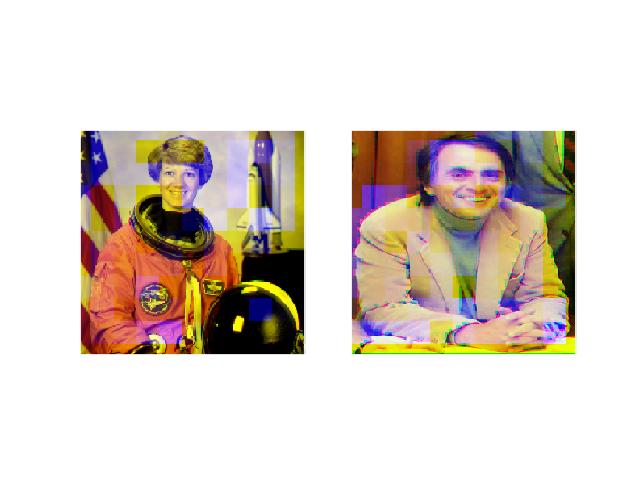
Example
>>> import kwcoco
>>> dset = kwcoco.CocoDataset.demo('vidshapes8-multispectral')
>>> delayed = dset.coco_image(1).delay(mode=0)
>>> from kwcoco.util.util_delayed_poc import * # NOQA
>>> astro = DelayedLoad.demo('astro')
>>> print('MSI = ' + ub.repr2(delayed.__json__(), nl=-3, sort=0))
>>> print('ASTRO = ' + ub.repr2(astro.__json__(), nl=2, sort=0))
>>> subchan = delayed.take_channels('B1|B8')
>>> subcrop = subchan.delayed_crop((slice(10, 80), slice(30, 50)))
>>> #
>>> subcrop.nesting()
>>> subchan.nesting()
>>> subchan.finalize()
>>> subcrop.finalize()
>>> #
>>> msi_crop = delayed.delayed_crop((slice(10, 80), slice(30, 50)))
>>> msi_warp = msi_crop.delayed_warp(kwimage.Affine.scale(3), dsize='auto')
>>> subdata = msi_warp.take_channels('B11|B1')
>>> final = subdata.finalize()
>>> assert final.shape == (210, 60, 2)
Example
>>> # test case where an auxiliary image does not map entirely on the image.
>>> from kwcoco.util.util_delayed_poc import * # NOQA
>>> import kwimage
>>> from os.path import join
>>> dpath = ub.ensure_app_cache_dir('kwcoco/tests/delayed_ops')
>>> chan1_fpath = join(dpath, 'chan1.tiff')
>>> chan2_fpath = join(dpath, 'chan2.tiff')
>>> chan3_fpath = join(dpath, 'chan2.tiff')
>>> chan1_raw = np.random.rand(128, 128, 1)
>>> chan2_raw = np.random.rand(64, 64, 1)
>>> chan3_raw = np.random.rand(256, 256, 1)
>>> kwimage.imwrite(chan1_fpath, chan1_raw)
>>> kwimage.imwrite(chan2_fpath, chan2_raw)
>>> kwimage.imwrite(chan3_fpath, chan3_raw)
>>> #
>>> c1 = channel_spec.FusedChannelSpec.coerce('c1')
>>> c2 = channel_spec.FusedChannelSpec.coerce('c2')
>>> c3 = channel_spec.FusedChannelSpec.coerce('c2')
>>> aux1 = DelayedLoad(chan1_fpath, dsize=chan1_raw.shape[0:2][::-1], channels=c1, num_bands=1)
>>> aux2 = DelayedLoad(chan2_fpath, dsize=chan2_raw.shape[0:2][::-1], channels=c2, num_bands=1)
>>> aux3 = DelayedLoad(chan3_fpath, dsize=chan3_raw.shape[0:2][::-1], channels=c3, num_bands=1)
>>> #
>>> img_dsize = (128, 128)
>>> transform1 = kwimage.Affine.coerce(scale=0.5)
>>> transform2 = kwimage.Affine.coerce(theta=0.5, shearx=0.01, offset=(-20, -40))
>>> transform3 = kwimage.Affine.coerce(offset=(64, 0)) @ kwimage.Affine.random(rng=10)
>>> part1 = aux1.delayed_warp(np.eye(3), dsize=img_dsize)
>>> part2 = aux2.delayed_warp(transform2, dsize=img_dsize)
>>> part3 = aux3.delayed_warp(transform3, dsize=img_dsize)
>>> delayed = DelayedChannelConcat([part1, part2, part3])
>>> #
>>> delayed_crop = delayed.crop((slice(0, 10), slice(0, 10)))
>>> delayed_final = delayed_crop.finalize()
>>> # xdoctest: +REQUIRES(--show)
>>> import kwplot
>>> kwplot.autompl()
>>> final = delayed.finalize()
>>> kwplot.imshow(final, fnum=1, pnum=(1, 2, 1))
>>> kwplot.imshow(delayed_final, fnum=1, pnum=(1, 2, 2))
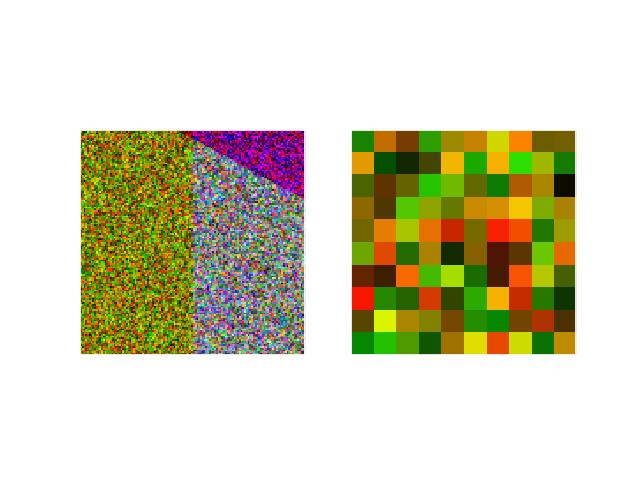
comp = delayed_crop.components[2]
comp.sub_data.finalize()
data = np.array([[0]]).astype(np.float32) kwimage.warp_affine(data, np.eye(3), dsize=(32, 32)) kwimage.warp_affine(data, np.eye(3))
kwimage.warp_affine(data[0:0], np.eye(3))
transform = kwimage.Affine.coerce(scale=0.1) data = np.array([[0]]).astype(np.float32)
data = np.array([[]]).astype(np.float32) kwimage.warp_affine(data, transform, dsize=(0, 2), antialias=True)
data = np.array([[]]).astype(np.float32) kwimage.warp_affine(data, transform, dsize=(10, 10))
data = np.array([[0]]).astype(np.float32) kwimage.warp_affine(data, transform, dsize=(0, 2), antialias=True)
data = np.array([[0]]).astype(np.float32) kwimage.warp_affine(data, transform, dsize=(10, 10))
- cv2.warpAffine(
kwimage.grab_test_image(dsize=(1, 1)), kwimage.Affine.coerce(scale=0.1).matrix[0:2], dsize=(0, 1),
)
- class kwcoco.util.util_delayed_poc.DelayedVisionOperation[source]¶
Bases:
NiceReprBase class for nodes in a tree of delayed computer-vision operations
- class kwcoco.util.util_delayed_poc.DelayedVideoOperation[source]¶
Bases:
DelayedVisionOperation
- class kwcoco.util.util_delayed_poc.DelayedImageOperation[source]¶
Bases:
DelayedVisionOperationOperations that pertain only to images
- delayed_crop(region_slices)[source]¶
Create a new delayed image that performs a crop in the transformed “self” space.
- Parameters
region_slices (Tuple[slice, slice]) – y-slice and x-slice.
Note
Returns a heuristically “simplified” tree. In the current implementation there are only 3 operations, cat, warp, and crop. All cats go at the top, all crops go at the bottom, all warps are in the middle.
- Returns
lazy executed delayed transform
- Return type
Example
>>> dsize = (100, 100) >>> tf2 = kwimage.Affine.affine(scale=3).matrix >>> self = DelayedWarp(np.random.rand(33, 33), tf2, dsize) >>> region_slices = (slice(5, 10), slice(1, 12)) >>> delayed_crop = self.delayed_crop(region_slices) >>> print(ub.repr2(delayed_crop.nesting(), nl=-1, sort=0)) >>> delayed_crop.finalize()
Example
>>> chan1 = DelayedLoad.demo('astro') >>> chan2 = DelayedLoad.demo('carl') >>> warped1a = chan1.delayed_warp(kwimage.Affine.scale(1.2).matrix) >>> warped2a = chan2.delayed_warp(kwimage.Affine.scale(1.5)) >>> warped1b = warped1a.delayed_warp(kwimage.Affine.scale(1.2).matrix) >>> warped2b = warped2a.delayed_warp(kwimage.Affine.scale(1.5)) >>> # >>> region_slices = (slice(97, 677), slice(5, 691)) >>> self = warped2b >>> # >>> crop1 = warped1b.delayed_crop(region_slices) >>> crop2 = warped2b.delayed_crop(region_slices) >>> print(ub.repr2(warped1b.nesting(), nl=-1, sort=0)) >>> print(ub.repr2(warped2b.nesting(), nl=-1, sort=0)) >>> # Notice how the crop merges the two nesting layers >>> # (via the hueristic optimize step) >>> print(ub.repr2(crop1.nesting(), nl=-1, sort=0)) >>> print(ub.repr2(crop2.nesting(), nl=-1, sort=0)) >>> frame1 = crop1.finalize(dsize=(500, 500)) >>> frame2 = crop2.finalize(dsize=(500, 500)) >>> # xdoctest: +REQUIRES(--show) >>> import kwplot >>> kwplot.autompl() >>> kwplot.imshow(frame1, pnum=(1, 2, 1), fnum=1) >>> kwplot.imshow(frame2, pnum=(1, 2, 2), fnum=1)

- class kwcoco.util.util_delayed_poc.DelayedIdentity(sub_data, dsize=None, channels=None, quantization=None)[source]¶
Bases:
DelayedImageOperationNoop leaf that does nothing. Can be used to hold raw data.
Typically used to just hold raw data.
DelayedIdentity.demo(‘astro’, chan=0, dsize=(32, 32))
Example
>>> from kwcoco.util.util_delayed_poc import * # NOQA >>> sub_data = np.random.rand(31, 37, 3) >>> self = DelayedIdentity(sub_data) >>> self = DelayedIdentity(sub_data, channels='L|a|b')
>>> # test with quantization >>> rng = kwarray.ensure_rng(32) >>> sub_data_quant = (rng.rand(31, 37, 3) * 1000).astype(np.int16) >>> sub_data_quant[0, 0] = -9999 >>> self = DelayedIdentity(sub_data_quant, channels='L|a|b', quantization={ >>> 'orig_min': 0., >>> 'orig_max': 1., >>> 'quant_min': 0, >>> 'quant_max': 1000, >>> 'nodata': -9999, >>> }) >>> final1 = self.finalize(dequantize=True) >>> final2 = self.finalize(dequantize=False) >>> assert np.all(np.isnan(final1[0, 0])) >>> scale = final2 / final1 >>> scales = scale[scale > 0] >>> assert np.all(np.isclose(scales, 1000)) >>> # check that take channels works >>> new_subdata = self.take_channels('a') >>> sub_final1 = new_subdata.finalize(dequantize=True) >>> sub_final2 = new_subdata.finalize(dequantize=False) >>> assert sub_final1.dtype.kind == 'f' >>> assert sub_final2.dtype.kind == 'i'
- kwcoco.util.util_delayed_poc.dequantize(quant_data, quantization)[source]¶
Helper for dequantization
- class kwcoco.util.util_delayed_poc.DelayedNans(dsize=None, channels=None)[source]¶
Bases:
DelayedImageOperationConstructs nan channels as needed
Example
self = DelayedNans((10, 10), channel_spec.FusedChannelSpec.coerce(‘rgb’)) region_slices = (slice(5, 10), slice(1, 12)) delayed = self.delayed_crop(region_slices)
Example
>>> from kwcoco.util.util_delayed_poc import * # NOQA >>> dsize = (307, 311) >>> c1 = DelayedNans(dsize=dsize, channels=channel_spec.FusedChannelSpec.coerce('foo')) >>> c2 = DelayedLoad.demo('astro', dsize=dsize).load_shape(True) >>> cat = DelayedChannelConcat([c1, c2]) >>> warped_cat = cat.delayed_warp(kwimage.Affine.scale(1.07), dsize=(328, 332)) >>> warped_cat.finalize()
#>>> cropped = warped_cat.delayed_crop((slice(0, 300), slice(0, 100))) #>>> cropped.finalize().shape
- property shape¶
- property num_bands¶
- property dsize¶
- property channels¶
- class kwcoco.util.util_delayed_poc.DelayedLoad(fpath, channels=None, dsize=None, num_bands=None, immediate_crop=None, immediate_chan_idxs=None, immediate_dsize=None, quantization=None)[source]¶
Bases:
DelayedImageOperationA load operation for a specific sub-region and sub-bands in a specified image.
Note
This class contains support for fusing certain lazy operations into this layer, namely cropping, scaling, and channel selection.
For now these are named
immediatesExample
>>> fpath = kwimage.grab_test_image_fpath() >>> self = DelayedLoad(fpath) >>> print('self = {!r}'.format(self)) >>> self.load_shape() >>> print('self = {!r}'.format(self)) >>> self.finalize()
>>> f1_img = DelayedLoad.demo('astro', dsize=(300, 300)) >>> f2_img = DelayedLoad.demo('carl', dsize=(256, 320)) >>> print('f1_img = {!r}'.format(f1_img)) >>> print('f2_img = {!r}'.format(f2_img)) >>> print(f2_img.finalize().shape) >>> print(f1_img.finalize().shape)
>>> fpath = kwimage.grab_test_image_fpath() >>> channels = channel_spec.FusedChannelSpec.coerce('rgb') >>> self = DelayedLoad(fpath, channels=channels)
Example
>>> # Test with quantization >>> fpath = kwimage.grab_test_image_fpath() >>> channels = channel_spec.FusedChannelSpec.coerce('rgb') >>> self = DelayedLoad(fpath, channels=channels, quantization={ >>> 'orig_min': 0., >>> 'orig_max': 1., >>> 'quant_min': 0, >>> 'quant_max': 256, >>> 'nodata': None, >>> }) >>> final1 = self.finalize(dequantize=False) >>> final2 = self.finalize(dequantize=True) >>> assert final1.dtype.kind == 'u' >>> assert final2.dtype.kind == 'f' >>> assert final2.max() <= 1
- property shape¶
- property num_bands¶
- property dsize¶
- property channels¶
- property fpath¶
- finalize(**kwargs)[source]¶
Todo
[ ] Load from overviews if a scale will be necessary
- Parameters
**kwargs –
- nodata_methodif specified this data item is treated as nodata, the
data is then converted to floats and the nodata value is replaced with nan.
- delayed_crop(region_slices)[source]¶
- Parameters
region_slices (Tuple[slice, slice]) – y-slice and x-slice.
- Returns
a new delayed load object with a fused crop operation
- Return type
Example
>>> # Test chained crop operations >>> from kwcoco.util.util_delayed_poc import * # NOQA >>> self = orig = DelayedLoad.demo('astro').load_shape() >>> region_slices = slices1 = (slice(0, 90), slice(30, 60)) >>> self = crop1 = orig.delayed_crop(slices1) >>> region_slices = slices2 = (slice(10, 21), slice(10, 22)) >>> self = crop2 = crop1.delayed_crop(slices2) >>> region_slices = slices3 = (slice(3, 20), slice(5, 20)) >>> crop3 = crop2.delayed_crop(slices3) >>> # Spot check internals >>> print('orig = {}'.format(ub.repr2(orig.__json__(), nl=2))) >>> print('crop1 = {}'.format(ub.repr2(crop1.__json__(), nl=2))) >>> print('crop2 = {}'.format(ub.repr2(crop2.__json__(), nl=2))) >>> print('crop3 = {}'.format(ub.repr2(crop3.__json__(), nl=2))) >>> # Test internals >>> assert crop3._immediates['crop'][0].start == 13 >>> assert crop3._immediates['crop'][0].stop == 21 >>> # Test shapes work out correctly >>> assert crop3.finalize().shape == (8, 7, 3) >>> assert crop2.finalize().shape == (11, 12, 3) >>> assert crop1.take_channels([1, 2]).finalize().shape == (90, 30, 2) >>> assert orig.finalize().shape == (512, 512, 3)
Note
This chart gives an intuition on how new absolute slice coords are computed from existing absolute coords ane relative coords. 5 7 <- new 3 5 <- rel -------- 01234567 <- relative coordinates -------- 2 9 <- curr ---------- 0123456789 <- absolute coordinates ----------
- take_channels(channels)[source]¶
This method returns a subset of the vision data with only the specified bands / channels.
- Parameters
channels (List[int] | slice | channel_spec.FusedChannelSpec) – List of integers indexes, a slice, or a channel spec, which is typically a pipe (|) delimited list of channel codes. See kwcoco.ChannelSpec for more detials.
- Returns
a new delayed load with a fused take channel operation
- Return type
Note
The channel subset must exist here or it will raise an error. A better implementation (via pymbolic) might be able to do better
Example
>>> from kwcoco.util.util_delayed_poc import * # NOQA >>> import kwcoco >>> self = DelayedLoad.demo('astro').load_shape() >>> channels = [2, 0] >>> new = self.take_channels(channels) >>> new3 = new.take_channels([1, 0])
>>> final1 = self.finalize() >>> final2 = new.finalize() >>> final3 = new3.finalize() >>> assert np.all(final1[..., 2] == final2[..., 0]) >>> assert np.all(final1[..., 0] == final2[..., 1]) >>> assert final2.shape[2] == 2
>>> assert np.all(final1[..., 2] == final3[..., 1]) >>> assert np.all(final1[..., 0] == final3[..., 0]) >>> assert final3.shape[2] == 2
- class kwcoco.util.util_delayed_poc.DelayedFrameConcat(frames, dsize=None)[source]¶
Bases:
DelayedVideoOperationRepresents multiple frames in a video
Note
Video[0]: Frame[0]: Chan[0]: (32) +--------------------------------+ Chan[1]: (16) +----------------+ Chan[2]: ( 8) +--------+ Frame[1]: Chan[0]: (30) +------------------------------+ Chan[1]: (14) +--------------+ Chan[2]: ( 6) +------+
Todo
[ ] Support computing the transforms when none of the data is loaded
Example
>>> # Simpler case with fewer nesting levels >>> rng = kwarray.ensure_rng(None) >>> # Delayed warp each channel into its "image" space >>> # Note: the images never enter the space we transform through >>> f1_img = DelayedLoad.demo('astro', (300, 300)) >>> f2_img = DelayedLoad.demo('carl', (256, 256)) >>> # Combine frames into a video >>> vid_dsize = np.array((100, 100)) >>> self = vid = DelayedFrameConcat([ >>> f1_img.delayed_warp(kwimage.Affine.scale(vid_dsize / f1_img.dsize)), >>> f2_img.delayed_warp(kwimage.Affine.scale(vid_dsize / f2_img.dsize)), >>> ], dsize=vid_dsize) >>> print(ub.repr2(vid.nesting(), nl=-1, sort=0)) >>> final = vid.finalize(interpolation='nearest', dsize=(32, 32)) >>> # xdoctest: +REQUIRES(--show) >>> import kwplot >>> kwplot.autompl() >>> kwplot.imshow(final[0], pnum=(1, 2, 1), fnum=1) >>> kwplot.imshow(final[1], pnum=(1, 2, 2), fnum=1) >>> region_slices = (slice(0, 90), slice(30, 60))
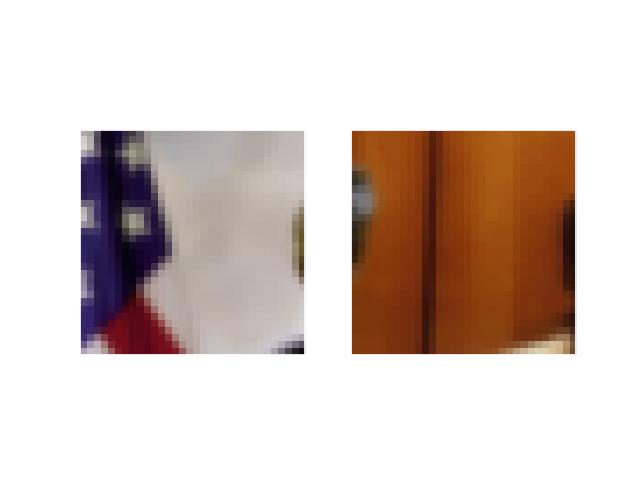
- property channels¶
- property shape¶
- delayed_crop(region_slices)[source]¶
- Returns
DelayedFrameConcat
Example
>>> from kwcoco.util.util_delayed_poc import * # NOQA >>> # Create raw channels in some "native" resolution for frame 1 >>> f1_chan1 = DelayedIdentity.demo('astro', chan=(1, 0), dsize=(300, 300)) >>> f1_chan2 = DelayedIdentity.demo('astro', chan=2, dsize=(10, 10)) >>> # Create raw channels in some "native" resolution for frame 2 >>> f2_chan1 = DelayedIdentity.demo('carl', dsize=(64, 64), chan=(1, 0)) >>> f2_chan2 = DelayedIdentity.demo('carl', dsize=(10, 10), chan=2) >>> # >>> f1_dsize = np.array(f1_chan1.dsize) >>> f2_dsize = np.array(f2_chan1.dsize) >>> f1_img = DelayedChannelConcat([ >>> f1_chan1.delayed_warp(kwimage.Affine.scale(f1_dsize / f1_chan1.dsize), dsize=f1_dsize), >>> f1_chan2.delayed_warp(kwimage.Affine.scale(f1_dsize / f1_chan2.dsize), dsize=f1_dsize), >>> ]) >>> f2_img = DelayedChannelConcat([ >>> f2_chan1.delayed_warp(kwimage.Affine.scale(f2_dsize / f2_chan1.dsize), dsize=f2_dsize), >>> f2_chan2.delayed_warp(kwimage.Affine.scale(f2_dsize / f2_chan2.dsize), dsize=f2_dsize), >>> ]) >>> vid_dsize = np.array((280, 280)) >>> full_vid = DelayedFrameConcat([ >>> f1_img.delayed_warp(kwimage.Affine.scale(vid_dsize / f1_img.dsize), dsize=vid_dsize), >>> f2_img.delayed_warp(kwimage.Affine.scale(vid_dsize / f2_img.dsize), dsize=vid_dsize), >>> ]) >>> region_slices = (slice(80, 200), slice(80, 200)) >>> print(ub.repr2(full_vid.nesting(), nl=-1, sort=0)) >>> crop_vid = full_vid.delayed_crop(region_slices) >>> final_full = full_vid.finalize(interpolation='nearest') >>> final_crop = crop_vid.finalize(interpolation='nearest') >>> import pytest >>> with pytest.raises(ValueError): >>> # should not be able to crop a crop yet >>> crop_vid.delayed_crop(region_slices) >>> # xdoctest: +REQUIRES(--show) >>> import kwplot >>> kwplot.autompl() >>> kwplot.imshow(final_full[0], pnum=(2, 2, 1), fnum=1) >>> kwplot.imshow(final_full[1], pnum=(2, 2, 2), fnum=1) >>> kwplot.imshow(final_crop[0], pnum=(2, 2, 3), fnum=1) >>> kwplot.imshow(final_crop[1], pnum=(2, 2, 4), fnum=1)
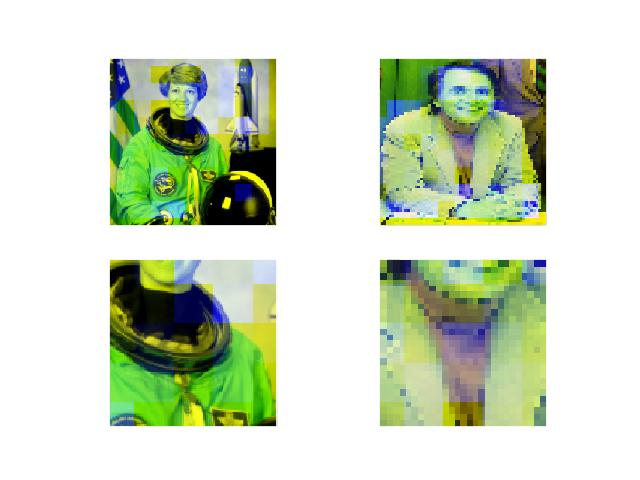
- class kwcoco.util.util_delayed_poc.JaggedArray(parts, axis)[source]¶
Bases:
NiceReprThe result of an unaligned concatenate
- property shape¶
- class kwcoco.util.util_delayed_poc.DelayedChannelConcat(components, dsize=None, jagged=False)[source]¶
Bases:
DelayedImageOperationRepresents multiple channels in an image that could be concatenated
- Variables
components (List[DelayedWarp]) – a list of stackable channels. Each component may be comprised of multiple channels.
Todo
[ ] can this be generalized into a delayed concat and combined with DelayedFrameConcat?
[ ] can all concats be delayed until the very end?
Example
>>> from kwcoco.util.util_delayed_poc import * # NOQA >>> # Create 3 delayed operations to concatenate >>> comp1 = DelayedWarp(np.random.rand(11, 7)) >>> comp2 = DelayedWarp(np.random.rand(11, 7, 3)) >>> comp3 = DelayedWarp( >>> np.random.rand(3, 5, 2), >>> transform=kwimage.Affine.affine(scale=(7/5, 11/3)).matrix, >>> dsize=(7, 11) >>> ) >>> components = [comp1, comp2, comp3] >>> chans = DelayedChannelConcat(components) >>> final = chans.finalize() >>> assert final.shape == chans.shape >>> assert final.shape == (11, 7, 6)
>>> # We should be able to nest DelayedChannelConcat inside virutal images >>> frame1 = DelayedWarp( >>> chans, transform=kwimage.Affine.affine(scale=2.2).matrix, >>> dsize=(20, 26)) >>> frame2 = DelayedWarp( >>> np.random.rand(3, 3, 6), dsize=(20, 26)) >>> frame3 = DelayedWarp( >>> np.random.rand(3, 3, 6), dsize=(20, 26))
>>> print(ub.repr2(frame1.nesting(), nl=-1, sort=False)) >>> frame1.finalize() >>> vid = DelayedFrameConcat([frame1, frame2, frame3]) >>> print(ub.repr2(vid.nesting(), nl=-1, sort=False))
Example
>>> from kwcoco.util.util_delayed_poc import * # NOQA >>> # If requested, we can return arrays of the different sizes. >>> # but usually this will raise an error. >>> comp1 = DelayedWarp.random(dsize=(32, 32), nesting=(1, 5), channels=1) >>> comp2 = DelayedWarp.random(dsize=(8, 8), nesting=(1, 5), channels=1) >>> comp3 = DelayedWarp.random(dsize=(64, 64), nesting=(1, 5), channels=1) >>> components = [comp1, comp2, comp3] >>> self = DelayedChannelConcat(components, jagged=True) >>> final = self.finalize() >>> print('final = {!r}'.format(final))
- classmethod random(num_parts=3, rng=None)[source]¶
Example
>>> self = DelayedChannelConcat.random() >>> print('self = {!r}'.format(self)) >>> print(ub.repr2(self.nesting(), nl=-1, sort=0))
- property channels¶
- property shape¶
- delayed_warp(transform, dsize=None)[source]¶
Delayed transform the underlying data.
Note
this deviates from kwimage warp functions because instead of “output_dims” (specified in c-style shape) we specify dsize (w, h).
- Returns
new delayed transform a chained transform
- Return type
- take_channels(channels)[source]¶
This method returns a subset of the vision data with only the specified bands / channels.
- Parameters
channels (List[int] | slice | channel_spec.FusedChannelSpec) – List of integers indexes, a slice, or a channel spec, which is typically a pipe (|) delimited list of channel codes. See kwcoco.ChannelSpec for more detials.
# Returns: # DelayedVisionOperation: # a delayed vision operation that only operates on the following # channels.
Example
>>> from kwcoco.util.util_delayed_poc import * # NOQA >>> import kwcoco >>> dset = kwcoco.CocoDataset.demo('vidshapes8-multispectral') >>> self = delayed = dset.coco_image(1).delay(mode=0) >>> channels = 'B11|B8|B1|B10' >>> new = self.take_channels(channels)
Example
>>> # Complex case >>> import kwcoco >>> from kwcoco.util.util_delayed_poc import * # NOQA >>> dset = kwcoco.CocoDataset.demo('vidshapes8-multispectral') >>> delayed = dset.coco_image(1).delay(mode=0) >>> astro = DelayedLoad.demo('astro').load_shape(use_channel_heuristic=True) >>> aligned = astro.warp(kwimage.Affine.scale(600 / 512), dsize='auto') >>> self = combo = DelayedChannelConcat(delayed.components + [aligned]) >>> channels = 'B1|r|B8|g' >>> new = self.take_channels(channels) >>> new_cropped = new.crop((slice(10, 200), slice(12, 350))) >>> datas = new_cropped.finalize() >>> vizable = kwimage.normalize_intensity(datas, axis=2) >>> # xdoctest: +REQUIRES(--show) >>> import kwplot >>> kwplot.autompl() >>> stacked = kwimage.stack_images(vizable.transpose(2, 0, 1)) >>> kwplot.imshow(stacked)
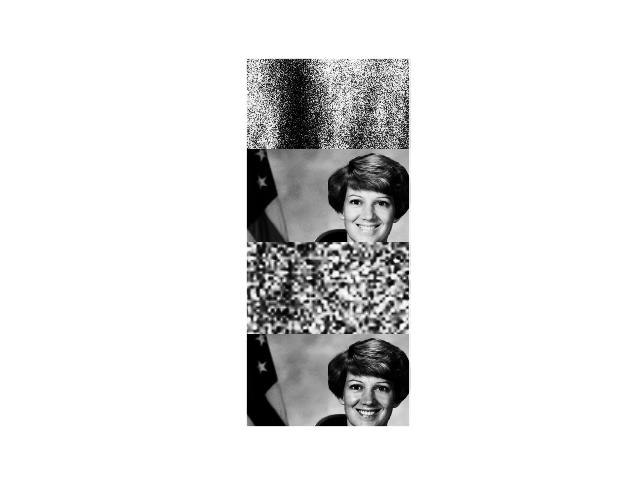
CommandLine
xdoctest -m /home/joncrall/code/kwcoco/kwcoco/util/util_delayed_poc.py DelayedChannelConcat.take_channels:2 --profile
Example
>>> # Test case where requested channel does not exist >>> import kwcoco >>> from kwcoco.util.util_delayed_poc import * # NOQA >>> dset = kwcoco.CocoDataset.demo('vidshapes8-multispectral', use_cache=1, verbose=100) >>> self = dset.coco_image(1).delay(mode=0) >>> channels = 'B1|foobar|bazbiz|B8' >>> new = self.take_channels(channels) >>> new_cropped = new.crop((slice(10, 200), slice(12, 350))) >>> fused = new_cropped.finalize() >>> assert fused.shape == (190, 338, 4) >>> assert np.all(np.isnan(fused[..., 1:3])) >>> assert not np.any(np.isnan(fused[..., 0])) >>> assert not np.any(np.isnan(fused[..., 3]))
- class kwcoco.util.util_delayed_poc.DelayedWarp(sub_data, transform=None, dsize=None)[source]¶
Bases:
DelayedImageOperationPOC for chainable transforms
Note
“sub” is used to refer to the underlying data in its native coordinates and resolution.
“self” is used to refer to the data in the transformed coordinates that are exposed by this class.
- Variables
sub_data (DelayedWarp | ArrayLike) – array-like image data at a native resolution
transform (kwimage.Transform) – transforms data from native “sub”-image-space to “self”-image-space.
Example
>>> dsize = (12, 12) >>> tf1 = np.array([[2, 0, 0], [0, 2, 0], [0, 0, 1]]) >>> tf2 = np.array([[3, 0, 0], [0, 3, 0], [0, 0, 1]]) >>> tf3 = np.array([[4, 0, 0], [0, 4, 0], [0, 0, 1]]) >>> band1 = DelayedWarp(np.random.rand(6, 6), tf1, dsize) >>> band2 = DelayedWarp(np.random.rand(4, 4), tf2, dsize) >>> band3 = DelayedWarp(np.random.rand(3, 3), tf3, dsize) >>> # >>> # Execute a crop in a one-level transformed space >>> region_slices = (slice(5, 10), slice(0, 12)) >>> delayed_crop = band2.delayed_crop(region_slices) >>> final_crop = delayed_crop.finalize() >>> # >>> # Execute a crop in a nested transformed space >>> tf4 = np.array([[1.5, 0, 0], [0, 1.5, 0], [0, 0, 1]]) >>> chained = DelayedWarp(band2, tf4, (18, 18)) >>> delayed_crop = chained.delayed_crop(region_slices) >>> final_crop = delayed_crop.finalize() >>> # >>> tf4 = np.array([[.5, 0, 0], [0, .5, 0], [0, 0, 1]]) >>> chained = DelayedWarp(band2, tf4, (6, 6)) >>> delayed_crop = chained.delayed_crop(region_slices) >>> final_crop = delayed_crop.finalize() >>> # >>> region_slices = (slice(1, 5), slice(2, 4)) >>> delayed_crop = chained.delayed_crop(region_slices) >>> final_crop = delayed_crop.finalize()
Example
>>> dsize = (17, 12) >>> tf = np.array([[5.2, 0, 1.1], [0, 3.1, 2.2], [0, 0, 1]]) >>> self = DelayedWarp(np.random.rand(3, 5, 13), tf, dsize=dsize) >>> self.finalize().shape
- classmethod random(dsize=None, raw_width=(8, 64), raw_height=(8, 64), channels=(1, 5), nesting=(2, 5), rng=None)[source]¶
Create a random delayed warp operation for testing / demo
- Parameters
dsize (Tuple[int, int] | None) – The width and height of the finalized data. If unspecified, it will be a function of the random warps.
raw_width (int | Tuple[int, int]) – The exact or min / max width of the random raw data
raw_height (int | Tuple[int, int]) – The exact or min / max height of the random raw data
nesting (Tuple[int, int]) – The exact or min / max random depth of warp nestings
channels (int | Tuple[int, int]) – The exact or min / max number of random channels.
- Returns
DelayedWarp
Example
>>> self = DelayedWarp.random(nesting=(4, 7)) >>> print('self = {!r}'.format(self)) >>> print(ub.repr2(self.nesting(), nl=-1, sort=0))
- property channels¶
- property dsize¶
- property num_bands¶
- property shape¶
- finalize(transform=None, dsize=None, interpolation='linear', **kwargs)[source]¶
Execute the final transform
Can pass a parent transform to augment this underlying transform.
- Parameters
transform (kwimage.Transform) – an additional transform to perform
dsize (Tuple[int, int]) – overrides destination canvas size
Example
>>> tf = np.array([[0.9, 0, 3.9], [0, 1.1, -.5], [0, 0, 1]]) >>> raw = kwimage.grab_test_image(dsize=(54, 65)) >>> raw = kwimage.ensure_float01(raw) >>> # Test nested finalize >>> layer1 = raw >>> num = 10 >>> for _ in range(num): ... layer1 = DelayedWarp(layer1, tf, dsize='auto') >>> final1 = layer1.finalize() >>> # Test non-nested finalize >>> layer2 = list(layer1._optimize_paths())[0] >>> final2 = layer2.finalize() >>> # >>> print(ub.repr2(layer1.nesting(), nl=-1, sort=0)) >>> print(ub.repr2(layer2.nesting(), nl=-1, sort=0)) >>> print('final1 = {!r}'.format(final1)) >>> print('final2 = {!r}'.format(final2)) >>> print('final1.shape = {!r}'.format(final1.shape)) >>> print('final2.shape = {!r}'.format(final2.shape)) >>> assert np.allclose(final1, final2) >>> # >>> # xdoctest: +REQUIRES(--show) >>> import kwplot >>> kwplot.autompl() >>> kwplot.imshow(raw, pnum=(1, 3, 1), fnum=1) >>> kwplot.imshow(final1, pnum=(1, 3, 2), fnum=1) >>> kwplot.imshow(final2, pnum=(1, 3, 3), fnum=1) >>> kwplot.show_if_requested()
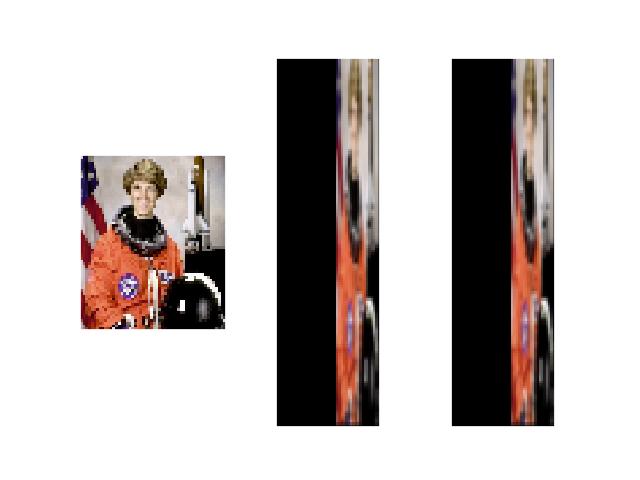
Example
>>> # Test aliasing >>> s = DelayedIdentity.demo() >>> s = DelayedIdentity.demo('checkerboard') >>> a = s.delayed_warp(kwimage.Affine.scale(0.05), dsize='auto') >>> b = s.delayed_warp(kwimage.Affine.scale(3), dsize='auto')
>>> # xdoctest: +REQUIRES(--show) >>> import kwplot >>> kwplot.autompl() >>> # It looks like downsampling linear and area is the same >>> # Does warpAffine have no alias handling? >>> pnum_ = kwplot.PlotNums(nRows=2, nCols=4) >>> kwplot.imshow(a.finalize(interpolation='area'), pnum=pnum_(), title='warpAffine area') >>> kwplot.imshow(a.finalize(interpolation='linear'), pnum=pnum_(), title='warpAffine linear') >>> kwplot.imshow(a.finalize(interpolation='nearest'), pnum=pnum_(), title='warpAffine nearest') >>> kwplot.imshow(a.finalize(interpolation='nearest', antialias=False), pnum=pnum_(), title='warpAffine nearest AA=0') >>> kwplot.imshow(kwimage.imresize(s.finalize(), dsize=a.dsize, interpolation='area'), pnum=pnum_(), title='resize area') >>> kwplot.imshow(kwimage.imresize(s.finalize(), dsize=a.dsize, interpolation='linear'), pnum=pnum_(), title='resize linear') >>> kwplot.imshow(kwimage.imresize(s.finalize(), dsize=a.dsize, interpolation='nearest'), pnum=pnum_(), title='resize nearest') >>> kwplot.imshow(kwimage.imresize(s.finalize(), dsize=a.dsize, interpolation='cubic'), pnum=pnum_(), title='resize cubic')
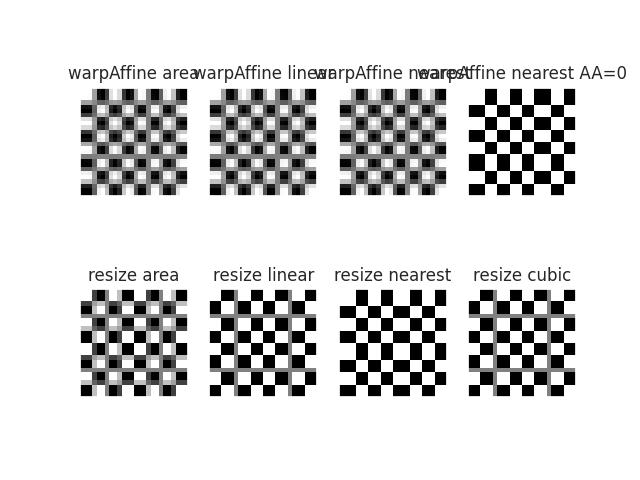
Example
>>> # xdoctest: +REQUIRES(--ipfs) >>> # Demo code to develop support for overviews >>> import kwimage >>> from kwcoco.util.util_delayed_poc import * # NOQA >>> fpath = ub.grabdata('https://ipfs.io/ipfs/QmaFcb565HM9FV8f41jrfCZcu1CXsZZMXEosjmbgeBhFQr', fname='PXL_20210411_150641385.jpg') >>> data0 = kwimage.imread(fpath, overview=0, backend='gdal') >>> data1 = kwimage.imread(fpath, overview=1, backend='gdal') >>> delayed_load = DelayedLoad(fpath=fpath) >>> delayed_load._ensure_dsize() >>> self = delayed_load.warp(kwimage.Affine.affine(scale=0.1), dsize='auto') >>> transform = kwimage.Affine.affine(scale=2.0) >>> imdata = self.finalize(transform=transform) >>> # xdoctest: +REQUIRES(--show) >>> import kwplot >>> kwplot.autompl() >>> kwplot.imshow(imdata)
- class kwcoco.util.util_delayed_poc.DelayedCrop(sub_data, sub_slices)[source]¶
Bases:
DelayedImageOperationRepresent a delayed crop operation
Example
>>> sub_data = DelayedLoad.demo() >>> sub_slices = (slice(5, 10), slice(1, 12)) >>> self = DelayedCrop(sub_data, sub_slices) >>> print(ub.repr2(self.nesting(), nl=-1, sort=0)) >>> final = self.finalize() >>> print('final.shape = {!r}'.format(final.shape))
Example
>>> sub_data = DelayedLoad.demo() >>> sub_slices = (slice(5, 10), slice(1, 12)) >>> crop1 = DelayedCrop(sub_data, sub_slices) >>> import pytest >>> # Should only error while huristics are in use. >>> with pytest.raises(ValueError): >>> crop2 = DelayedCrop(crop1, sub_slices)
- property channels¶